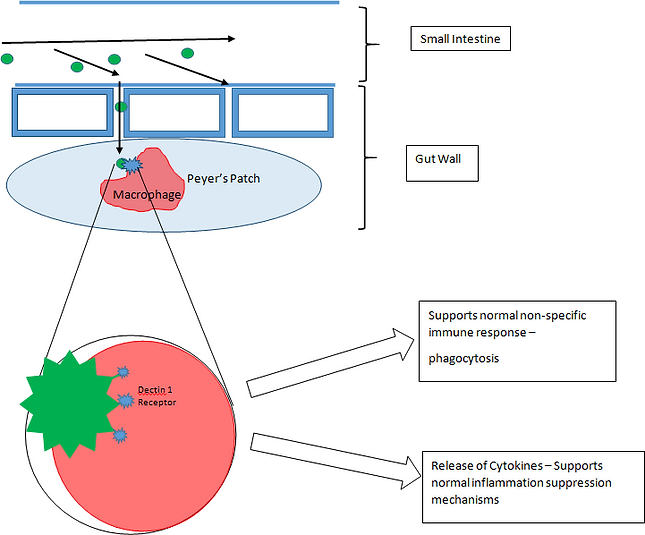Written by Dr. Tom Shurlock for and on behalf of GWF Nutrition Limited.
Knowledge Base
Beta Glucans - What do they do?
Copyright: GWF Nutrition Limited - Not for Reproduction.
Biochemically the name of a product tends to describe it. A product ending in ‘ans’ means it consists of a limited number of the same sugar molecule (in this case glucose) in some form of chain which may or may not be soluble. Sugar molecules can have isomers – that is, versions where the arrangement of molecules is slightly different. For glucans the main isomers are alpha (dextrose, glycogen, starch), or beta (cellulose, laminarin, cereal or yeast β-glucans). When beta glucose molecules link their linkages cannot be broken by animal enzymes, only by some bacteria. As such, when ingested, they tend to pass through the intestine unchanged and are broken down in the hind gut by bacterial fermentation.
It is this property that give glucan a number of different characteristics. It is the form of the chain, the linkages and the position it occupies in its progress through the gut that allows it support normal inflammation related systems, immunomodulation and to act as a prebiotic.
A prebiotic is a term that has been used to describe a non-digestible supplement or nutrient (usually a small segment of fibre) which, when included in the diet, significantly increases certain species in the gut of target species. Beta glucans have been shown to increase bifidobacteria and lactobacilli which is considered to improve the wellbeing of the gut environment. It therefore acts as a food source for some, but not all, bacteria and these benefit and grow. Their fermentation of the prebiotic tends to result in higher proportions of butyric acid which benefits the gut wall cells. Increasing these bacteria also mean that other fibre present in the hind gut will be broken down by them and so there is a positive impact on the availability of nutrients.
However, the role of beta glucans is more than just prebiotic. It can be a part of the natural processes that help maintain the body’s defenses against some forms of trauma.
Within the gut wall in the small intestine are cells known as Peyers Patches(Gut Associated Lymphoid Tissue – GALT) which are linked to the lymph system. As such they have direct impact on the immune defence system. They are also involved in combatting other invasive particles including cancer cells and allergenic particles.
Although they cannot be broken down into smaller particles by animal enzymes, beta glucans can pass through the gut, by increasing the gaps between the cells, penetrating intact and also allowing the passage of other “stimulatory” nutrients.
The first line of defence at the level of the Peyers Patches is the release of macrophages and other components called mucosa associated lymphoid tissue (MALT). Macrophage is a type of white blood cell whose function is to engulf foreign material that gets into the body and is non-specific. Before the body starts manufacturing antibodies to invasive material, macrophages are providing basic defence.
While other invasive particles excite the MALT, beta glucans has a specific role. Beta glucans can vary from a single chain with each connection through the same linkage, as a chain where the links vary and as a chain with side branches. Depending on the position of these links and chains some versions can attach themselves onto the macrophage. The macrophage has, on its surface, sites called Dectin 1 which acts as a lock to the beta glucans, as long as the glucans has a sequence of 1,3 links that fits. When the Dectin 1 recognises the glucan it is activated to perform one of two functions, and this will depend on associated activity of the MALT.
In direct response to glucans the macrophage releases a number of factors including cytokines that help counter inflammatory factors.
At the same time beta glucans can aid the stimulation of an immune response by generating active cells that scavenge and destroy bacteria, by stimulating the macrophage to engulf alien particles and act on MALT to generate antibody response specific to an invasive pathogen.

So ts passage along the gastrointestinal tract beta glucan helps maintain normal immune and inflammation systems through its ability to open up interstitial junctions between cells and be recognised by GALT generated cells, and to stimulate MALT to help maintain a broad range of inflammation and immune response control.
Consequently, some beta glucans reaches the hind gut where it is fermented by and supports populations of bifidobacteria and lactobacilli which in term generate end products useful to the function of the colon and caecum, helping to maintain a beneficial environment.
Beta glucans are present in the cell wall material of many classes of organisms. In cereals oat and barley fibre are particularly rich, but recently many yeast and algae cell wall materials are being introduced into the market. This raises the question whether they are all the same product.
The quick answer is no. Cereal glucans has slightly different linkages to yeast and algae and although these two latter have more linkages in common the proportion of side chains does impact on function. However, when looked at more closely, it would seem they all have the three prong activities at the gut level.
